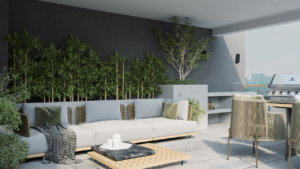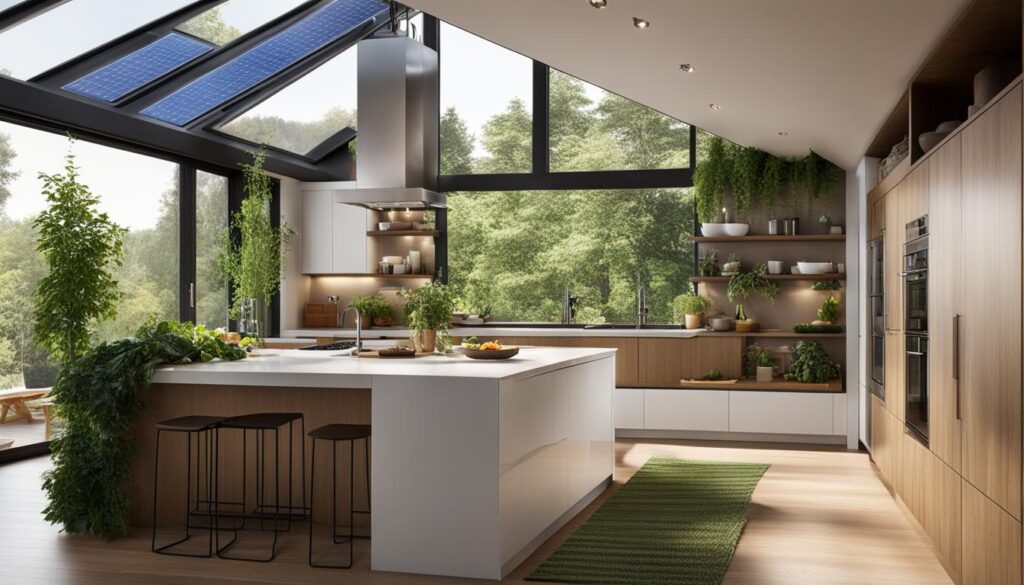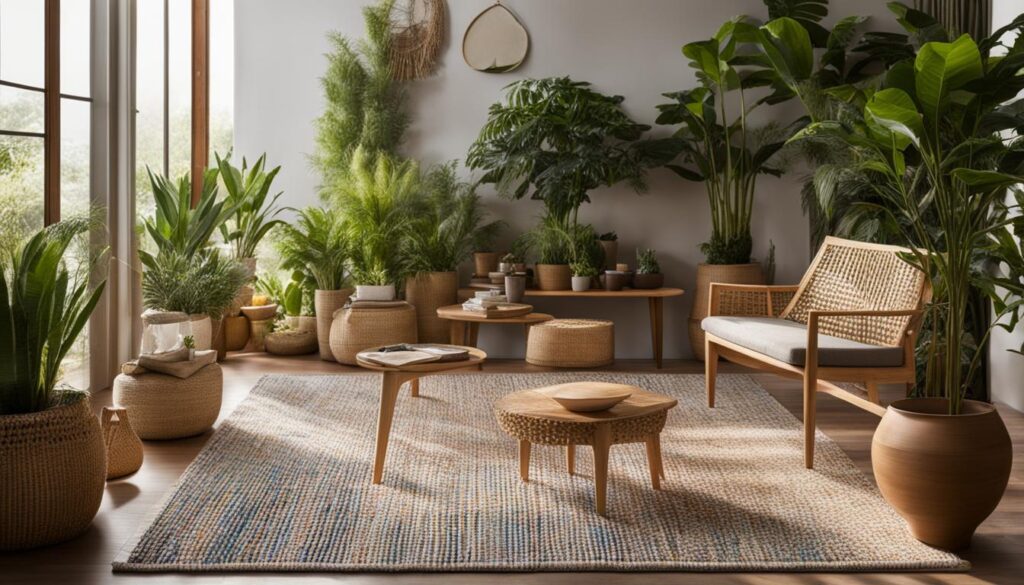Welcome to our guide on eco-friendly interior design, where sustainability meets style, and environmental consciousness is celebrated. In today’s world, more and more individuals are realizing the importance of sustainable living and making conscious choices that minimize negative environmental impacts. When it comes to designing our living spaces, incorporating eco-friendly principles not only creates aesthetically pleasing interiors but also helps us contribute to a greener future.
Key Takeaways:
- Eco-friendly interior design focuses on creating sustainable and stylish spaces.
- It involves making conscious choices that minimize negative environmental impacts.
- Eco-friendly design strategies include energy efficiency, waste reduction, and using sustainable materials.
- Creating an environmentally conscious home promotes a healthier planet for future generations.
- Sustainable interior design contributes to improving indoor air quality, conserving energy, and protecting natural resources.
The Importance of Sustainable Interior Design
Sustainable interior design plays a crucial role in minimizing harm to the environment and promoting a healthier planet. By incorporating eco-responsible practices and materials, you can create an eco-friendly home that not only benefits the environment but also enhances your well-being. Sustainable interior design focuses on minimizing negative environmental impacts and maximizing the use of renewable resources, ultimately creating spaces that are both stylish and environmentally conscious.
When designing an eco-friendly home, several key factors come into play:
- Reducing Energy Consumption: By employing energy-efficient strategies such as proper insulation, LED lighting, and smart home technology, sustainable interior design helps minimize energy use and lower carbon emissions. This not only reduces environmental impact but also saves costs in the long run.
- Conserving Water: Sustainable interior design incorporates water-saving fixtures, rainwater harvesting systems, and greywater recycling, reducing water consumption and preserving this valuable resource.
- Improving Indoor Air Quality: Selecting low VOC (Volatile Organic Compounds) materials and utilizing natural ventilation methods contribute to better indoor air quality, ensuring a healthier living environment for occupants.
- Protecting Natural Resources: Sustainable interior design emphasizes the use of responsibly sourced materials, such as reclaimed wood and recycled materials, to minimize the depletion of natural resources and reduce waste.
Adopting sustainable interior design principles goes beyond just reducing environmental impact. It creates spaces that prioritize the well-being of individuals and communities. The conscious choices made in sustainable interior design contribute to a healthier, greener future for all.
Sustainable interior design not only minimizes harm to the environment but also promotes the overall well-being of individuals and communities.
| Benefits of Sustainable Interior Design |
|---|
| Reduces energy consumption and lowers carbon emissions |
| Conserves water resources through efficient fixtures and systems |
| Improves indoor air quality for a healthier living environment |
| Protects natural resources by using responsibly sourced materials |
Eco-Friendly Interior Design Creating an Energy-Efficient Home
Energy consumption is a significant contributor to environmental change, and buildings play a major role in energy consumption. Sustainable interior designers can make a difference by focusing on energy efficiency and design strategies that minimize energy consumption. By incorporating these strategies, you can create a home that not only reduces its environmental impact but also saves you money in the long run.
Passive Design
One of the key approaches to energy-efficient design is passive design. This design strategy aims to maximize the building’s natural heating, cooling, and lighting capabilities, minimizing the need for excessive energy consumption. By strategically placing windows to capture natural light and heat, utilizing shading devices to prevent heat gain in the summer, and optimizing insulation to reduce heat loss in the winter, you can create a comfortable indoor environment without relying heavily on artificial heating or cooling systems.
Renewable Energy Sources
Another effective way to enhance energy efficiency in your home is by harnessing renewable energy sources. Incorporating solar panels allows you to generate your own electricity using the power of the sun. By utilizing this clean and abundant source of energy, you can reduce your reliance on traditional energy sources and decrease your carbon footprint. Investing in energy-efficient appliances and LED lighting also contributes to minimizing energy consumption and maximizing the use of renewable energy in your home.
Windows and Insulation
When it comes to energy-efficient design, high-quality windows and good insulation are essential. Windows with double or triple glazing and low-E coatings can significantly reduce heat transfer, keeping your home cool in the summer and warm in the winter. Proper insulation in walls, floors, and roofs prevents heat loss or gain, maintaining a comfortable indoor temperature year-round and reducing the need for excessive heating or cooling.
Curtains and Blinds
Using curtains and blinds is an effective way to control the temperature in your home and minimize energy consumption. Thick curtains with thermal linings provide insulation and prevent heat loss during the cold weather. Similarly, reflective blinds help block out excessive heat from the sun during hot summer days. By strategically opening and closing curtains and blinds, you can regulate the amount of natural light and heat entering your home, reducing the need for artificial lighting and cooling.
Energy-Efficient Appliances and Lighting
Reducing the energy consumption of appliances and lighting is a key aspect of creating an energy-efficient home. When purchasing new appliances, look for energy-efficient models with the Energy Star label. These appliances are designed to minimize energy use without compromising functionality or performance. Additionally, replacing traditional incandescent bulbs with LED lighting can significantly reduce energy consumption and increase the lifespan of your lighting fixtures.
| Energy-Saving Strategies | Benefits |
|---|---|
| Passive design | Maximizes natural heating, cooling, and lighting, reduces reliance on artificial systems |
| Renewable energy sources | Reduces reliance on traditional energy sources, decreases carbon footprint |
| High-quality windows and insulation | Minimizes heat transfer, maintains comfortable indoor temperature |
| Curtains and blinds | Controls natural light and heat, reduces need for artificial lighting and cooling |
| Energy-efficient appliances and lighting | Reduces energy consumption, increases lifespan of appliances and lighting fixtures |
Reducing Waste and Promoting Recycling
Waste reduction is a fundamental principle of sustainable interior design that aims to minimize the environmental impact of our choices. By repurposing and upcycling existing furniture and decor items instead of discarding them, designers can effectively reduce waste and contribute to a more sustainable lifestyle. Embracing the concept of circular design, where materials are reused or regenerated, allows us to minimize the consumption of new resources and minimize waste generation.
Choosing durable materials that can be easily recycled or repurposed at the end of their life cycle is another effective strategy for waste reduction. By opting for products made from recycled or recyclable materials, we can establish a closed-loop system that minimizes the environmental impact of our choices.
“The greatest threat to our planet is the belief that someone else will save it.” – Robert Swan
Benefits of Waste Reduction:
- Minimizes landfill waste and its associated environmental impacts
- Conserves natural resources by reducing the demand for new materials
- Reduces greenhouse gas emissions generated from waste disposal
- Saves energy and reduces pollution associated with the manufacturing of new products
The Three R’s: Recycling, Upcycling, and Repurposing
In the journey towards waste reduction, three key practices play a significant role: recycling, upcycling, and repurposing. Recycling involves converting waste materials into new products, thus extending their life cycle and reducing the need for virgin materials. Upcycling takes discarded or unused items and transforms them into something of higher value or quality, providing a creative way to give old objects new life. Repurposing involves finding alternative uses for items that serve a different purpose than originally intended, contributing to resourceful and sustainable design solutions.
By incorporating recycling, upcycling, and repurposing into our design practices, we not only minimize waste but also create unique and personalized spaces that showcase our creativity and commitment to sustainability.
| Benefits of Waste Reduction | Three R’s: Recycling, Upcycling, and Repurposing |
|---|---|
|
|
Eco-Friendly Interior Design Choosing Sustainable Materials and Products
When it comes to sustainable interior design, selecting the right materials and products is crucial. By opting for sustainable materials, responsible sourcing, and eco-friendly alternatives, you can significantly reduce your environmental impact and create a more environmentally-friendly home.
One of the key considerations in sustainable interior design is the use of sustainable materials. Materials like bamboo, cork, and responsibly sourced wood are excellent choices due to their low environmental impact. These materials are renewable, biodegradable, and can be sustainably harvested, making them a more eco-friendly option than traditional alternatives.
It is also important to consider the life cycle of materials and products. This includes evaluating their extraction, production, transportation, and disposal processes. By selecting materials that have a low environmental impact throughout their life cycle, you can ensure that your choices align with sustainable design principles.
The Benefits of Choosing Sustainable Materials and Products
“By selecting sustainable materials and products, you contribute to the preservation of our environment and help create a greener future for generations to come.”
Choosing sustainable materials and products offers several benefits. Firstly, it reduces the demand for non-renewable resources, promoting responsible consumption. Secondly, it minimizes waste and the need for landfill disposal by prioritizing materials that can be easily recycled or repurposed. Lastly, opting for sustainable alternatives supports responsible sourcing practices that prioritize fair trade and social responsibility.
Let’s take a moment to look at a table highlighting some sustainable materials, their benefits, and potential applications:
| Sustainable Material | Benefits | Potential Applications |
|---|---|---|
| Bamboo | Eco-friendly, fast-growing, renewable | Flooring, furniture, decor items |
| Cork | Sustainable, renewable, sound-absorbing | Flooring, wall coverings, insulation |
| Responsibly Sourced Wood | Renewable, biodegradable, durable | Furniture, cabinetry, millwork |
As seen in the table, sustainable materials like bamboo, cork, and responsibly sourced wood present excellent choices for various applications in interior design. By incorporating these materials into your space, you can create a stylish and environmentally-conscious home.
Exploring Eco-Friendly Alternatives
While sustainable materials offer great options, there are also eco-friendly alternatives available for various design elements. For example, you may choose low VOC (volatile organic compound) paint for walls and ceilings. These paints have lower levels of harmful emissions, improving indoor air quality and reducing health risks.
Here is a list of eco-friendly alternatives for common interior design products:
- Recycled glass countertops instead of traditional granite or marble
- Recycled plastic rugs or natural fiber rugs
- LED lighting instead of incandescent bulbs
- Water-saving fixtures for faucets and showers
- Organic fabrics and textiles for upholstery and curtains
By choosing eco-friendly alternatives, you can further minimize your environmental impact and create a more sustainable living space.
Designing for Health and Well-being
Designing for health and well-being is a crucial aspect of sustainable interior design. Not only should our living spaces be aesthetically pleasing, but they should also promote a healthy and harmonious environment. From improving indoor air quality to maximizing natural lighting, incorporating biophilic design elements, and reducing toxic emissions, there are various ways we can create spaces that prioritize our well-being and connection with nature.
Promoting Indoor Air Quality
Indoor air quality plays a significant role in our overall health and well-being. Unfortunately, many conventional building materials and products release VOCs (Volatile Organic Compounds), which can negatively impact the air we breathe. To create a healthier indoor environment, it is essential to choose materials with low VOC emissions. These materials emit fewer toxins into the air and help minimize the risk of respiratory issues and other health problems.
Maximizing Natural Lighting
Natural lighting not only enhances the visual appeal of a space but also has numerous health benefits. Exposure to natural light helps regulate our circadian rhythm, improves mood and productivity, and reduces the risk of eye strain and other vision-related problems. Incorporating large windows, skylights, or light tubes can increase the amount of natural light in a space, creating a brighter and more inviting atmosphere.
Integrating Biophilic Design Elements
Biophilic design focuses on incorporating natural elements into our built environments to enhance our well-being. By incorporating elements such as plants, natural materials, and water features, we can create a sense of connection with nature. Studies have shown that biophilic design has a positive impact on stress reduction, cognitive function, and overall mental well-being. It is a powerful way to bring the benefits of nature indoors.
Creating a Healthy and Harmonious Space
Designing for health and well-being involves creating spaces that promote a sense of balance and harmony. By choosing sustainable materials, maximizing natural ventilation, and creating spaces that promote movement and relaxation, we can foster a healthy and inspiring environment. Whether it’s designing a home, office, or public space, prioritizing our well-being through sustainable interior design principles benefits both individuals and communities.
Conclusion
Sustainable interior design offers a powerful solution for creating greener and more Eco-Friendly Interior Design. By incorporating energy-efficient strategies, reducing waste, prioritizing health and well-being, and choosing sustainable materials, we can collectively contribute to a more sustainable future. Whether you’re designing a residential, commercial, or industrial space, embracing eco-friendly principles not only benefits the environment but also adds aesthetic appeal. By taking action and implementing sustainable design practices, we can create stylish and environmentally conscious interiors that make a positive impact on our planet’s health.
As we strive to create a greener future, it’s important to be mindful of our choices as consumers and designers. Sustainable design allows us to minimize our carbon footprint and promote a more sustainable lifestyle. By prioritizing energy efficiency through passive design, using renewable energy sources, and reducing overall energy consumption, we can significantly contribute to reducing environmental impacts and combating climate change.
Reducing waste and promoting recycling is another crucial aspect of sustainable interior design. By repurposing, upcycling, and choosing materials that can be easily recycled or repurposed, we can minimize waste and contribute to a circular economy. Additionally, selecting sustainable materials with low environmental impact and prioritizing indoor air quality through the use of low VOC materials and natural ventilation can enhance both the health and well-being of occupants.
In conclusion, sustainable interior design offers a holistic approach to creating greener and more environmentally friendly spaces. By incorporating eco-friendly principles into our design practices, we can create stylish, functional, and sustainable interiors that contribute to a greener future for generations to come. Let’s continue to champion sustainable design and make a positive impact on our planet, one interior at a time.
FAQ
What is eco-friendly interior design?
Eco-friendly interior design is a sustainable and stylish approach to creating spaces that minimize negative environmental impacts. It involves making conscious choices to reduce energy consumption, use eco-friendly products, and maximize a building’s potential through passive design.
Why is sustainable interior design important?
Sustainable interior design is crucial for minimizing harm to the environment and promoting a healthier planet. By creating eco-friendly homes, we can reduce energy consumption, conserve water, improve indoor air quality, and protect natural resources, benefiting both individuals and communities.
How can I create an energy-efficient home?
To create an energy-efficient home, you can focus on strategies such as using high-quality windows with good insulation, utilizing curtains and blinds for temperature control, and incorporating renewable energy sources like solar power. By reducing the need for heating, lighting, and energy for appliances, you can make your home more energy-efficient.
How can I reduce waste and promote recycling in my home?
To reduce waste, you can repurpose and upcycle existing furniture and decor items instead of throwing them away. Choosing durable materials that can be easily recycled or repurposed at the end of their life cycle also helps minimize waste. Adopting a circular approach to manufacturing and using products made from recycled materials contribute to a more sustainable lifestyle.
What are some sustainable materials and products I can use in my home?
Opting for sustainable materials like bamboo, cork, and responsibly sourced wood can have a low environmental impact. Additionally, considering the life cycle of materials and products, including their extraction, production, transportation, and disposal, is important. Selecting low-impact materials and eco-friendly alternatives helps create a more sustainable and environmentally-friendly home.
How can I design for health and well-being in my home?
Designing for health and well-being involves choosing materials with low VOC emissions to improve indoor air quality. Promoting natural ventilation and incorporating elements like plants and natural lighting can also enhance well-being and create a connection with nature. Biophilic design principles, which focus on bringing nature indoors, further enhance the health and well-being benefits of sustainable interior design.
How does sustainable interior design contribute to a greener future?
By implementing energy-efficient strategies, reducing waste, choosing sustainable materials, and prioritizing health and well-being, sustainable interior design helps create greener and more sustainable homes. Whether it’s a residential, commercial, or industrial space, incorporating eco-friendly principles into interior design benefits the environment while also creating aesthetically pleasing interiors.












